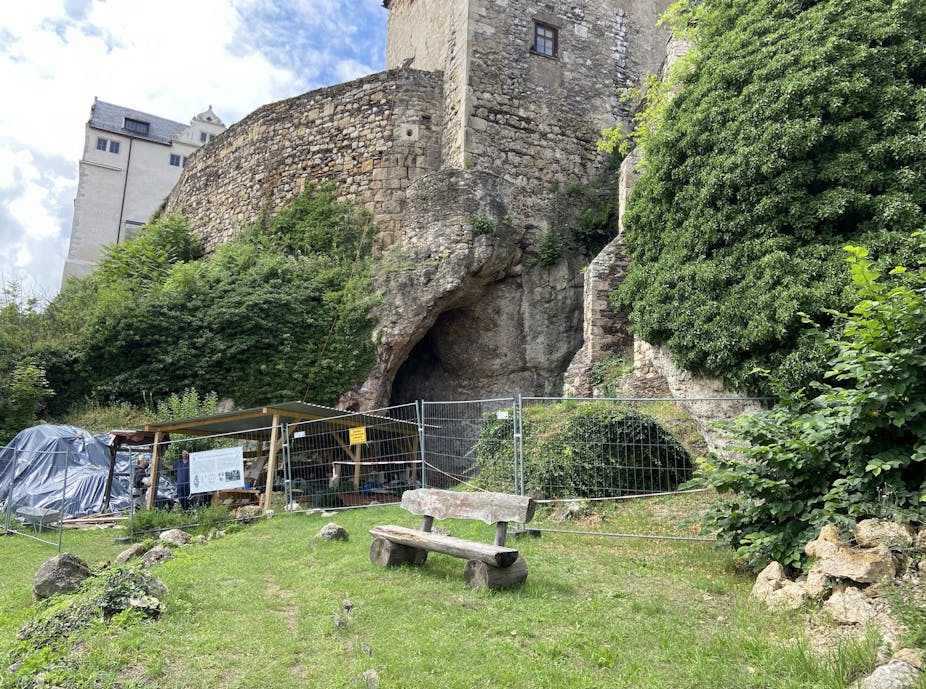The period between 50,000 to 40,000 years ago saw a crucial biological and cultural transformation for humans: this was the time when local groups of Neanderthals were replaced by incoming groups of our own species, Homo sapiens.
The exact reasons behind this replacement are still poorly understood, but recent advances in archaeological and biomolecular science – combined with new archaeological discoveries – have provided illuminating new insights into the northward dispersal of early groups of Homo sapiens.
Our research – published today in Nature – has used these new techniques to the fullest, opening a new chapter in our understanding of how modern humans came to inhabit northwestern Europe.
Ranis: a stone age mystery?

In the 1930s, at the site of Ilsenhöhle in Ranis (Thuringia, Germany), Werner M. Hülle uncovered a wealth of archaeological materials, including stone tools linked to the transition between the Middle Palaeolithic (Neanderthal) and Upper Palaeolithic (Homo sapiens). This stone tool industry – known as the Lincombian-Ranisian-Jerzmanowician (LRJ) – can be traced across central and northwest Europe, from Czechia to Britain.
Hülle was not able to identify human remains in the LRJ layers at Ranis. Poor bone preservation at many other LRJ sites meant there was strong debate about whether these tools had been made by Neanderthals or early Homo sapiens.
Our team re-excavated the Ranis site from 2016 to 2022. This was done by an international research group, led by Jean-Jacques Hublin, Shannon McPherron, Tim Schüler and Marcel Weiss. Over the course of our work, we successfully located the trenches from Hülle’s excavation, and found remaining LRJ deposits at a depth of nearly 8 metres.

Identifying ancient human remains
Around 1,800 bone fragments were recovered thanks to the new excavation. However, heavy fragmentation meant that only around 10% of the LRJ bone material could be identified to species. To increase the identification rate, we sampled previously unidentifiable bone fragments from both new and old excavations, and used new proteomic methods (analysing ancient proteins) to provide further species identifications.

It was a welcome surprise when we identified human remains, from both our new excavations and those from the 1930s: for the first time, human remains had been securely identified from an LRJ layer. Further visual assessment of the 1930s bone fragments brought the total number of identified human fragments up to thirteen.
Ancient DNA analysis identified all of these human fragments as Homo sapiens. A series of direct radiocarbon dates then securely placed them around 45,000 years ago.
Early humans as climate-resilient hunters
These human fossils were found alongside bone remains from reindeer, bison, woolly rhinoceros, arctic fox, wolf and wolverine, suggesting an extremely cold environment. This was confirmed by temperature estimates obtained by looking at oxygen isotopes on horse teeth, suggesting sub-arctic, tundra-like climate conditions similar to modern day northwestern Russia.
While some animal bones had clear traces of being butchered by humans, a lot of the material showed clear signs of being consumed by hyenas. Both archaeological analysis and data extracted directly from human remains show a diet based on large herbivores – especially reindeer and horse – with a focus on highly nutritious bone marrow. We also identified cut marks on carnivores, including wolves, suggesting that their furs were used to combat the cold.

We were also able to compare our species identifications on bone with those identified in ancient sediment DNA samples. By doing this, we found an increase in carnivore DNA in layers with more herbivore remains and material that had been consumed by carnivores. Overall, it is clear that the Ranis cave was used intermittently by hyenas, hibernating bears, and small, pioneer groups of climate-resilient Homo sapiens.
New understandings of early human presence in northwest Europe
Our work marks a significant shift in the understanding of Homo sapiens‘ initial incursions into the plains of northwestern Europe 47,500 years ago, which took place under severely cold climatic conditions. Moving in small groups, they shared their environment and sites with large carnivores, such as hyenas, and manufactured finely made stone points.
The brief use of the Ranis cave by small groups of Homo sapiens contrasts with evidence from the same period of their longer and more intensive presence at Bacho Kiro Cave in Bulgaria. This shows that we are only beginning to understand the settlement dynamics of the earliest dispersals of Homo sapiens into Europe, as well as their interactions with groups of local Neanderthals.
With a new suite of analytical tools at our disposal, and with large quantities of bone material available to study – both from new excavations and existing museum collections – we are now entering a new and exciting phase of archaeological research into the coexistence of our species with Neanderthals.


